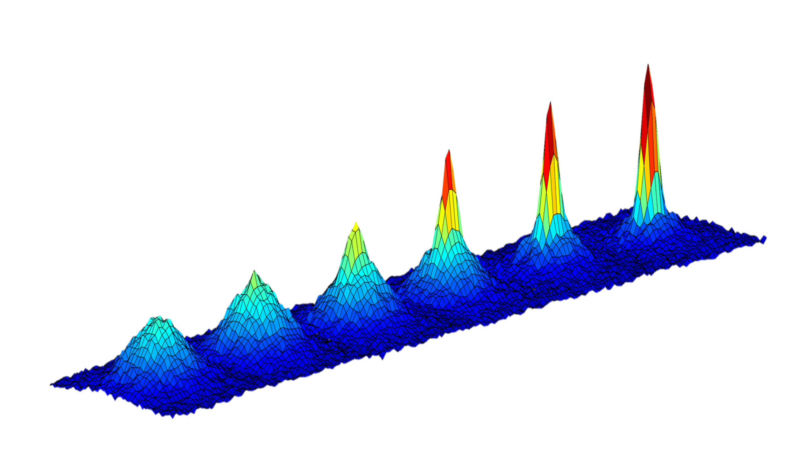https://arstechnica.com/?p=1358011

At the heart of Einstein’s theory of gravity (general relativity) is the equivalence principle. The equivalence principle says that there is no difference between being stationary and subject to gravity tugging you versus accelerating in a vehicle that’s free of gravitational pull.
In practice, this means that there is no difference between inertial mass (the mass a rocket works on) and gravitational mass (the mass the Earth tugs on). This equivalence has been measured time and time again with no violation ever found. But, these tests assumed that quantum mechanics didn’t change the equivalent principle: that assumption is partially wrong.
Some quantum in your equivalence
In relativity, mass and energy are two sides of the same coin. For very small objects, we need to think about that in terms of quantum mechanics, where a particle can be in a superposition of energy states. A particle in a superposition of energy states has two energies at the same time until it is measured, whereupon it has a single fixed energy. An object in a superposition of energetic states can have a superposition of inertial masses. But does it have the same superposition of gravitational masses?
The intent of the equivalence principle says yes, it should. But the mathematical statement of the equivalence principle takes no account of the quantum properties of the objects.
Now a pair of researchers have picked up that thread and started pulling on it. They have re-formulated the equivalence principle so that it takes into account the way energy may be distributed internally in a quantum object.
Their conclusion is that, while the classical equivalence principle requires that the classical inertial mass and gravitational mass are the same, this is not enough for quantum mechanics. And now we get a bit technical. In a quantum system, the researchers also found that the inertial mass and gravitational mass operators must commute. What does that mean?
Commutation
In terms of physics, when two operators commute, it means that we can measure the physical quantity of one and not disturb the value of the other. To provide the most famous example, position and momentum do not commute. If we measure the position of an electron, we lose information about the momentum. If we then measure the momentum of the same electron, we will lose information about its position. The same is not true for momentum and energy. If I measure the momentum and then measure the energy, I do not lose information about the momentum.
In a sense the statement that inertial mass and gravitational mass must commute is trivial: if the inertial mass and the gravitational mass are the same, then they have the same operators and they must commute. If that were not true, it would be the equivalent of saying that measuring the momentum of an electron destroys knowledge about the momentum of the electron. That does not make sense.
Likewise, measuring the mass of a particle does not destroy knowledge about the mass of the particle. However, if inertial mass and gravitational mass are different, then measuring the inertial mass makes the gravitational mass uncertain.
The consequence is that classical tests of the equivalent principle may find agreement when, in fact, the test violates the equivalence principle. Additional measurements are required to confirm that equivalence holds for quantum objects.
Sensitive to a difference in mass
Let’s take an example. Physicists sometimes use a Bose Einstein condensate (BEC) to test the equivalence principle. A BEC is a blob of atoms that acts like a single quantum particle. The blob is split in two equal parts and sent along two different paths to meet up again. In one path, the BEC blob is put into a superposition state: the BEC is in two energetic states simultaneously. Gravity acts on both blobs, but its effect should be different because one blob has a different internal state.
When the two blobs meet, they interfere, resulting in patches of material that create bright and dark areas on a screen. If everything goes perfectly and the equivalence principle holds, then the dark patches are completely dark and the bright patches are all equally bright.
If inertial mass and gravitational mass are different, then the interference will not be perfect. The bright patches will not be as bright, and the dark patches will have some light.
There are similar differences for a variety of different quantum tests of the quantum equivalence principle; the others are very difficult. The researchers examined four different experiments and found that for three of them, current and near-future experiments would not be sensitive enough. For the one remaining method, an earlier experiment had proven the viability of the method, and had found that the equivalence principle held.
Not all equivalence principles are equivalent
I should note that I have been skating over a lot of technicalities here. In particular the equivalence principle can be split into a combination of the weak equivalence principle, local Lorentz invariance, and local position invariance. Together, these three make up Einstein’s equivalence principle. Typically, most experiments only test a subset of these three (and usually only the weak equivalence principle).
Here, however, the researchers are dealing with all three. If experiments can be improved to the point that they can perform the measurements suggested in this paper, then it will represent the strongest test for Einstein’s equivalence principle yet.
Nature Physics, 2018, DOI: 10.1038/s41567-018-0197-6. (About DOIs)
via Ars Technica https://arstechnica.com
August 14, 2018 at 09:41AM
